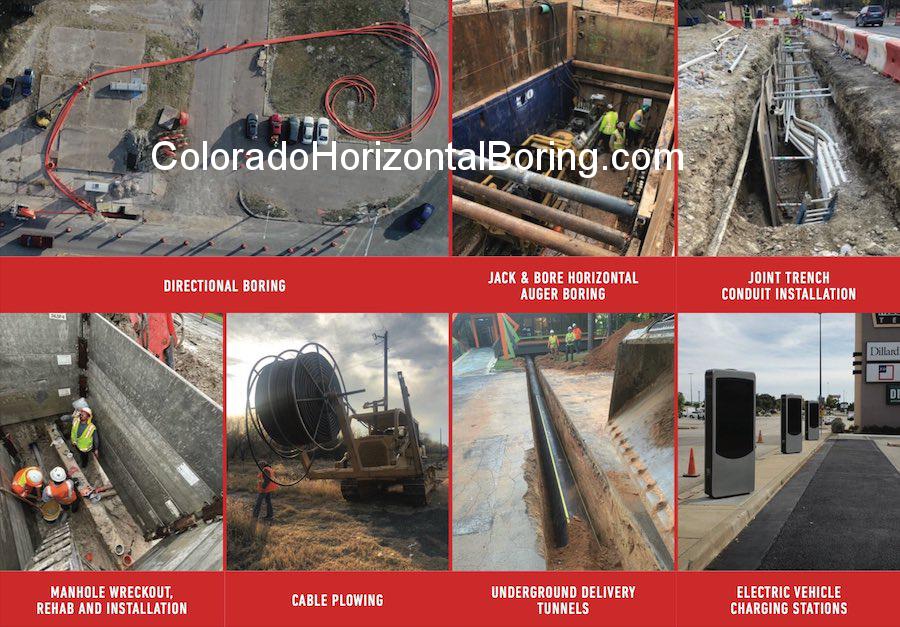Potholing Services
Potholing also known as (Vacuum Excavation, Utility Potholing, Vacuum Potholing, Hydro-Vac Services and Potholing Services) is the practice of digging a test hole to expose underground utilities to ascertain the horizontal and vertical location of the facility.
The horizontal and vertical position of the exposed facility must be tied to a survey benchmark or permanent above grade feature. The position may be identified by GPS or traditional survey coordinates or by measuring the distance, with a tape measure, to permanent features in three horizontal directions. In addition, the vertical distance below grade should be obtained.
Nearly all municipalities and utility companies consider potholing mandatory.
The four stages of utility potholing are:
1. Utility Location and Surface Opening
2. Exposing (Daylighting Utilities)
3. Soil Extraction (Water+Air Vacuum)
4. Utility Depth Measurement & Mapping
Colorado Horizontal Boring Utility Pipes Types | HDPE Pipe
Colorado Horizontal Boring Utility Pipes Types | HDPE Pipe
HDPE pipe also called poly or polyethylene pipe is ideal for many different underground utility applications including municipal, industrial, energy, geothermal and landfill. HDPE pipe is strong, durable, flexible and lightweight. When heat (butt) fused together, HDPE has a zero leak rate because the fusion process creates a monolithic HDPE system. HDPE pipe is also a more environmentally sustainable option because its non-toxic, corrosion and chemical resistant. HDPE has a long design life, and is ideal for trenchless installation methods because of its flexibility.
HDPE pipe meets or exceeds operating temperatures and pressures. HDPE pipe is an excellent insulator, with minimal heat transfer. Copper transfers heat 2,700 times more than HDPE. HDPE does not become brittle at 32 degrees Fahrenheit. HDPE does not leak because it is seamlessly fused. HDPE does not corrode.
We prefer using HDPE over other the alternatives in nearly every underground utility installation project we bore.
Colorado Horizontal Boring Utility Pipes Types | PVC Pipe
Colorado Horizontal Boring Utility Pipes Types | PVC Pipe
Regular PVC (polyvinyl chloride) is a common, strong but lightweight plastic used in underground construction. It is made softer and more flexible by the addition of plasticizers.Roughly half of the worlds polyvinyl chloride resin manufactured annually is used for producing pipes for municipal and industrial applications. In the water distribution market it accounts for 66% of the market in the US, and in sanitary sewer pipe applications, it accounts for 75%.
Applications for this technology cover every aspect of piping installations including both pressure and non-pressure situations in the water, sewer, electrical, industrial and telecommunications industries.
PVC has been used for over 50 years. Owner and contractor familiarity of the pipe is well established.
PVC is todays most widely utilized pipe material in the United States.
PVC has superior stiffness (modulus) compared to other plastic pipe, which limits long term deformation under soil load.
High tensile strength (ASTM D638) of the fused joint (up to 7,000 psi) allows for higher safe pulling stresses and consequently longer installation pull-in lengths.
PVC resists hydrocarbon permeation better than other thermoplastic pipe systems (AWWA Research Foundation).
Low wall thickness for given pressure requirement translates into highest flow per outer diameter (OD) dimension.
PVC is more resistant to water disinfectant induced oxidation than other thermoplastic pipe systems.
PVC material properties have low time dependencies the properties do not change over time no pull-in relaxation period for example.
Colorado Horizontal Boring Utility Pipes Types | Steel Pipe
Colorado Horizontal Boring Utility Pipes Types | Steel Pipe
Steel casing pipe protects one or many of various types of utilities such as water mains, gas pipes, electrical power cables, fiber optic cables, etc.
The utility lines that are run through the steel casing pipe are most commonly mounted and spaced within the steel casing pipe by using casing spacers that are made of various materials, including stainless steel or carbon steel and the more economical plastic versions.
Steel pipe is often required for casing underneath roads, highways and railroads particularly for wet utilities like water mains, sewer lines and oil and natural gas pipelines.
With our larger directional drilling rigs we can pull steel casing hundreds to a couple thousand feet.


